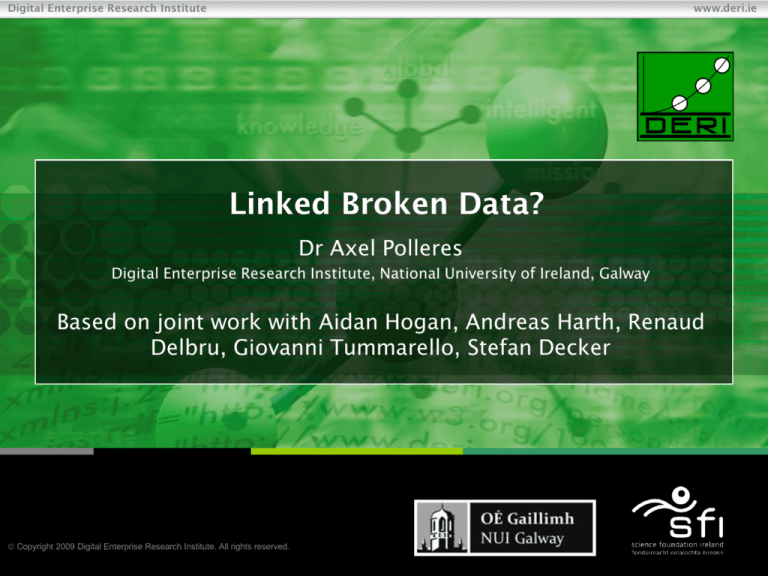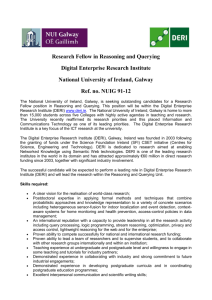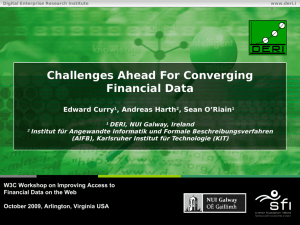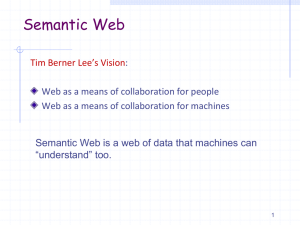
Digital Enterprise Research Institute
www.deri.ie
Linked Broken Data?
Dr Axel Polleres
Digital Enterprise Research Institute, NationaI University of Ireland, Galway
Based on joint work with Aidan Hogan, Andreas Harth, Renaud
Delbru, Giovanni Tummarello, Stefan Decker
Copyright 2009 Digital Enterprise Research Institute. All rights reserved.
Digital Enterprise Research Institute
Today’s talk is about…
Reasoning on today’s Semantic Web…
6
www.deri.ie
The Web map 2008 © Tim Berners-Lee
Digital Enterprise Research Institute
7
http://www.w3.org/2007/09/map/main.jpg
www.deri.ie
The Web map 2008 © Tim Berners-Lee
Digital Enterprise Research Institute
www.deri.ie
more and more structured data (RDF) available on the Web thanks to …
… vocabularies (RDFS+OWL) becoming established
… exporters, (GRDDL, RDFa), Linked Open Data, etc.
… In this talk: What can we do with it already in terms of Reasoning?
8
Outline
Digital Enterprise Research Institute
www.deri.ie
Brief intro of RDF/OWL/Linked Open Data
Reasoning over Web Data: Challenges
Reasoning over Web Data: Dealing with the challenges
9
Reasoning in Sindice.com
Reasoning in SWSE.com
How to avoid common mistakes upfront:
Inconsistencies
Common mistakes
RDFAlerts, Pedantic-Web Group
What I’d hope you to take-home
Example: Finding experts/reviewers?
Digital Enterprise Research Institute
www.deri.ie
Tim Berners-Lee, Dan Connolly, Lalana Kagal, Yosi Scharf, Jim Hendler: N3Logic:
A logical framework for the World Wide Web. Theory and Practice of Logic
Programming (TPLP), Volume 8, p249-269
Who are the right reviewers? Who has the right expertise?
Which reviewers are in conflict?
Observation: Most of the necessary data already on the Web!
More and more of it follows the Linked Data principles, i.e.:
10
1.
Use URIs as names for things
2.
Use HTTP dereferenceable URIs so that people can look up those names.
3.
When someone looks up a URI, provide useful information.
4.
Include links to other URIs so that they can discover more things.
RDF on the Web
Digital Enterprise Research Institute
www.deri.ie
(i) directly by the publishers
(ii) by e.g. GRDDL transformations, D2R, RDFa exporters, etc.
FOAF/RDF linked from a home page: personal data (foaf:name, foaf:phone,
etc.), relationships foaf:knows, rdfs:seeAlso )
11
RDF on the Web
Digital Enterprise Research Institute
www.deri.ie
(i) directly by the publishers
(ii) by e.g. GRDDL transformations, D2R, RDFa exporters, etc.
e.g. L3S’ RDF export of the DBLP citation index, using FUB’s D2R (http://dblp.l3s.de/d2r/)
Gives unique URIs to authors, documents, etc. on DBLP! E.g.,
http://dblp.l3s.de/d2r/resource/authors/Tim_Berners-Lee,
http://dblp.l3s.de/d2r/resource/publications/journals/tplp/Berners-LeeCKSH08
Provides RDF version of all DBLP data + query interface!
12
RDF Data online: Example
Digital Enterprise Research Institute
www.deri.ie
Data in RDF: Triples
DBLP:
<http://dblp.l3s.de/…/journals/tplp/Berners-LeeCKSH08> rdf:type swrc:Article.
<http://dblp.l3s.de/…/journals/tplp/Berners-LeeCKSH08> dc:creator
<http://dblp.l3s.de/d2r/…/Tim_Berners-Lee> .
…
<http://dblp.l3s.de/d2r/…/Tim_Berners-Lee> foaf:homepage
<http://www.w3.org/People/Berners-Lee/> .
…
<http://dblp.l3s.de/d2r/…/Dan_Brickley> foaf:name “Dan Brickley”^^xsd:string.
Tim Berners-Lee’s FOAF file:
<http://www.w3.org/People/Berners-Lee/card#i> foaf:knows
<http://dblp.l3s.de/d2r/…/Dan_Brickley> .
<http://www.w3.org/People/Berners-Lee/card#i> rdf:type foaf:Person .
<http://www.w3.org/People/Berners-Lee/card#i> foaf:homepage
<http://www.w3.org/People/Berners-Lee/> .
13
Linked Open Data
Digital Enterprise Research Institute
www.deri.ie
…
March 2008
March 2009
14
Excellent tutorial here: http://www4.wiwiss.fu- berlin.de/bizer/pub/LinkedDataTutorial/
How can I query that data? SPARQL
Digital Enterprise Research Institute
www.deri.ie
SPARQL – W3C approved standardized query language for RDF:
look-and-feel of “SQL for the Web”
allows to ask queries like
– “All documents by Tim Berners-Lee”
– “Names of all persons who co-authored with authors of
http://dblp.l3s.de/d2r/…/Berners-LeeCKSH08 or known by co-authors”
…
Example:
SELECT ?D
FROM <http://dblp.l3s.de/…/authors/Tim_Berners-Lee>
WHERE {?D dc:creator <http://dblp.l3s.de/…/authors/Tim_Berners-Lee>}
15
SPARQL more complex patters: e.g. UNIONs
Digital Enterprise Research Institute
“Names of all persons who co-authored with authors of
http://dblp.l3s.de/d2r/…/Berners-LeeCKSH08 or known by co-authors”
SELECT ?Name WHERE
{ <http://dblp.l3s.de/d2r/resource/publication/journals/tplp/Berners-LeeCKSH08>
dc:creator ?Author.
?D dc:creator ?Author.
?D dc:creator ?CoAuthor.
?CoAuthor foaf:name ?Name
}
16
www.deri.ie
SPARQL more complex patters: e.g. UNIONs
Digital Enterprise Research Institute
“Names of all persons who co-authored with authors of
http://dblp.l3s.de/d2r/…/Berners-LeeCKSH08 or known by co-authors”
SELECT ?Name WHERE
{ <http://dblp.l3s.de/d2r/resource/publications/journals/tplp/Berners-LeeCKSH08>
dc:creator ?Author.
?D dc:creator ?Author.
?D dc:creator ?CoAuthor.
{ ?CoAuthor foaf:name ?Name . }
UNION
{ ?CoAuthor foaf:knows ?Person.
?Person rdf:type foaf:Person.
?Person foaf:name ?Name }
}
17
Doesn’t work… no foaf:knows relations in DBLP
Needs Linked Data! E.g. TimBL’s FOAF file!
www.deri.ie
Back to the Data:
Digital Enterprise Research Institute
www.deri.ie
DBLP:
<http://dblp.l3s.de/…/journals/tplp/Berners-LeeCKSH08> rdf:type swrc:Article.
<http://dblp.l3s.de/…/journals/tplp/Berners-LeeCKSH08> dc:creator
<http://dblp.l3s.de/d2r/…/Tim_Berners-Lee> .
…
<http://dblp.l3s.de/d2r/…/Tim_Berners-Lee> foaf:homepage
<http://www.w3.org/People/Berners-Lee/> .
Tim Berners-Lee’s FOAF file:
<http://www.w3.org/People/Berners-Lee/card#i> foaf:knows
<http://dblp.l3s.de/d2r/…/Dan_Brickley> .
<http://www.w3.org/People/Berners-Lee/card#i> foaf:homepage
<http://www.w3.org/People/Berners-Lee/> .
18
Even if I have the FOAF data, I cannot answer the query:
Different identifiers used for Tim Berners-Lee
Who tells me that Dan Brickley is a foaf:Person?
Linked Data needs Reasoning!
Reasoning on Semantic Web Data
Digital Enterprise Research Institute
www.deri.ie
Vocabularies (i.e. collections of classes and properties that
belong together, e.g. foaf:):
Properties: foaf:name foaf:homepage, foaf:knows
Classes:
foaf:Person, foaf:Document
Typically should have formal descriptions of their structure:
RDF Schema, and OWL
These formal descriptions often “called” ontologies.
Ontologies add “semantics” to the data.
Ontologies are themselves written in RDF, using special
vocabularies (rdf:, rdfs:, owl:) with special semantics
Ontologies are themselves part of the Linked Data Web!
19
Ontologies: Example FOAF
Digital Enterprise Research Institute
foaf:knows rdfs:domain foaf:Person
Everybody who knows someone is a Person
foaf:knows rdfs:range foaf:Person
Everybody who is known is a Person
foaf:Person rdfs:subclassOf foaf:Agent
Everybody Person is an Agent.
foaf:homepage rdf:type owl:inverseFunctionalProperty .
A homepage uniquely identifies its owner (“key” property)
…
20
www.deri.ie
RDFS+OWL inference by rules 1/2
Digital Enterprise Research Institute
www.deri.ie
Semantics of RDFS can be partially expressed as (Datalog like) rules:
rdfs1: { ?S rdf:type ?C } :- { ?S ?P ?O . ?P rdfs:domain ?C . }
rdfs2: { ?O rdf:type ?C } :- { ?S ?P ?O . ?P rdfs:range ?C . }
rdfs3: { ?S rdf:type ?C2 } :- {?S rdf:type ?C1 . ?C1 rdfs:subclassOf ?C2 . }
cf. informative Entailment rules in [RDF-Semantics, W3C, 2004], [Muñoz et al. 2007]
21
RDFS+OWL inference by rules 2/2
Digital Enterprise Research Institute
www.deri.ie
OWL Reasoning e.g. inverseFunctionalProperty can also (partially) be expressed by Rules:
owl1: { ?S1 owl:SameAs ?S2 } :{ ?S1 ?P ?O . ?S2 ?P ?O . ?P rdf:type owl:InverseFunctionalProperty }
owl2: { ?Y ?P ?O } :- { ?X owl:SameAs ?Y . ?X ?P ?O }
owl3: { ?S ?Y ?O } :- { ?X owl:SameAs ?Y . ?S ?X ?O }
owl4: { ?S ?P ?Y } :- { ?X owl:SameAs ?Y . ?S ?P ?X }
cf. pD* fragment of OWL, [ter Horst, 2005], or, more recent: OWL2 RL
22
RDFS+OWL inference by rules: Example:
Digital Enterprise Research Institute
By rules of the previous slides we can infer additional information needed, e.g.
TimBL’s FOAF:
FOAF Ontology:
by rdfs2
<…/Berners-Lee/card#i> foaf:knows <…/Dan_Brickley> .
foaf:knows rdfs:range foaf:Person
<…/Dan_Brickley> rdf:type
TimBL’s FOAF:
foaf:Person.
<…/Berners-Lee/card#i> foaf:homepage
<http://www.w3.org/People/Berners-Lee/> .
<…/dblp.l3s.de/d2r/…/Tim_Berners-Lee> foaf:homepage
DBLP:
FOAF Ontology:
by owl1
23
www.deri.ie
<http://www.w3.org/People/Berners-Lee/> .
foaf:homepage rdfs:type owl:InverseFunctionalProperty.
<…/Berners-Lee/card#i> owl:sameAs <…/Tim_Berners-Lee>.
Who tells me that Dan Brickley is a foaf:Person? solved!
Different identifiers used for Tim Berners-Lee solved!
RDFS+OWL inference, what’s missing?
Digital Enterprise Research Institute
Note: Not all of OWL Reasoning can be expressed in Datalog
straightforwardly, e.g.:
foaf:Person owl:disjointWith foaf:Organisation
Can be written/and reasoned about with FOL/DL reasoners:
Problem: Inconsistencies! Complete FOL/DL reasoning is not necessarily
suitable for Web data…
24
www.deri.ie
Why is complete reasoning non-optimal anyways?
Digital Enterprise Research Institute
Our use case: Search the Semantic Web!
Hypothetically: The explosive semantics of inconsistencies
in DL/FOL reasoning would spoil our results.
What if we throw all into one big KB? one inconsistency…
a owl:differentFrom a .
:me ex:age “old”^^xs:integer.
… would make everything true.
25
www.deri.ie
Inconsistencies/wrong inferences on Web Data
Digital Enterprise Research Institute
www.deri.ie
4 main reasons
Least common
Publishers deliberately publish spoilt data (“SPAM”)
Opinions differ
“URI-sense” ambiguities
Accidently wrong/inconsistent
26
Most common
Publishers deliberately publish spoilt data (“SPAM”)
Digital Enterprise Research Institute
27
www.deri.ie
Examples:
a owl:differentFrom a .
http://www.polleres.net/nasty.rdf
Can occur for “testdata” being published, deliberate
SPAM can become an issue, as the SW grows!
Opinions differ
Digital Enterprise Research Institute
Fictitous Example Ontology:
Originofthings.example.org:
o1:surpremePower owl:disjointWith o1:naturalPhenomenom.
o1:originsFrom rdf:type owl:functionalProperty.
o1:god rdf:type o1:surpremePower.
o1:evolution rdf:type o1:naturalPhenomenom.
darwin.example.org:
ex:mankind o1:originsFrom o1:evolution .
creationism.example.org:
ex:mankind o1:originsFrom o1:god
FlyingSpaghettimonster.org
fsm::theSpaghettiMonster rdf:type surpremePower.
ex:mankind o1:originsFrom fsm:theSpaghettiMonster.
28
www.deri.ie
“URI-sense” ambiguities
Digital Enterprise Research Institute
www.deri.ie
<http://www.polleres.net>
foaf:knows <http://apassant.net>
i.e., why do I have to use a different URI for myself
and my homepage?
Many people don’t understand/like this and make
mistakes.
But is this really a mistake or a design error?
29
Accidentially inconsistent data
Digital Enterprise Research Institute
:me ex:age "old"^^xs:integer.
can e.g. arise from an exporter, that collects age from a form
Source1 (faulty):
TimBL foaf:homepage <http://www.w3.org>
TimBL rdf:type foaf:Person.
W3.org:
W3C foaf:homepage <http://www.w3.org>
W3C rdf:type foaf:Organisation.
Did occur in our Web crawls at some point, people don’t have the right
semantics in mind!
Suspiciously resembles problems with e.g. flawed HTML …
browsers, normal search engines still have to deal with it
So do we!
30
www.deri.ie
Accidently wrong (non-inconsistent data)
Digital Enterprise Research Institute
FOAF Ontology:
foaf:mbox rdf:type owl:InverseFunctionalProperty
Careless FOAF exporters produce something like
this for any empty email address:
ex:alice foaf:mbox “mailto:”
ex:bob foaf:mbox “mailto:”
…
IFP reasoning (Rules: owl1-4) on Web Data equates
too many things! Dangerous!
31
www.deri.ie
How can I reason about Web Data in a
Semantic Search Engine?
Digital Enterprise Research Institute
www.deri.ie
http://swse.deri.org
http://sindice.com
Datawarehouse approach, e.g. SWSE
crawling, harvesting, SPARQL interface, RDFS+resricted OWL reasoning
Search/Lookup indices for the Semantic Web, e.g. Sindice
32
Indexing RDF sources on the Web, go there and query yourself
Requirements:
Digital Enterprise Research Institute
Scale
“Humble” Inference
Both engines crawl millions, even billions of triples (rapidly
increasing) … latest numbers talk about orders of 100B RDF
triples online.
Both want to do at least limited inferencing to deliver valuable
implicit information/connections
Tolerance
Both should be tolerant/cautious against common faults
– Filter if possible deliberate mess
– Filter (repair?) Accidential errors
– Keep inconsistencies local
33
www.deri.ie
2 approaches
Digital Enterprise Research Institute
www.deri.ie
Sindice:
Uses a standard rule-based OWL engine (OWLIM, ter Horst’s pD* rules)
Inferencing “per document”, only importing necessary ontologies
Keeps an “ontology cache” for all crawled ontologies for efficiency
No cross-document inferences
SWSE+SAOR:
Works on whole crawl (huge file)
– Existing solutions, e.g. OWLIM don’t work on that, infer too much
34
Our own reasoner: SAOR (scalable authoritative OWL reasoner)
Reasoning in Sindice:
Digital Enterprise Research Institute
www.deri.ie
Implicit import
Based on W3C best practices – Linked Data Principles
By dereferencing class or property URI
:me rdf:type foaf:Person .
:me foaf:name "Renaud Delbru" .
http://www.w3.org/1999/02/22-rdf-syntax-ns
http://xmlns.com/foaf/spec/
→ foaf:name rdf:type owl:DatatypeProperty .
http://www.w3.org/2002/07/owl
→ owl:DatatypeProperty rdf:type rdf:Property .
35
Reasoning in Sindice:
Ontology Cache: Update Strategy
Digital Enterprise Research Institute
1. Import closure of Doc1 is materialised
36
www.deri.ie
Reasoning in Sindice:
Ontology Cache: Update Strategy
Digital Enterprise Research Institute
1. Import closure of Doc1 is materialised
2. Compute deductive closure of aggregate context OA, OB, OC
37
www.deri.ie
Reasoning in Sindice:
Ontology Cache: Update Strategy
Digital Enterprise Research Institute
1. Import closure of Doc1 is materialised
2. Compute deductive closure of aggregate context OA, OB, OC
3. Store ∆A,B,C in a separate named RDF triple set
38
www.deri.ie
Reasoning in Sindice:
Ontology Cache: Update Strategy
Digital Enterprise Research Institute
A new document is coming, importing only OA and OC :
1. Compute deductive closure of OA and OC
39
www.deri.ie
Reasoning in Sindice:
Ontology Cache: Update Strategy
Digital Enterprise Research Institute
A new document is coming, importing only OA and OC :
1. Compute deductive closure of OA and OC
2. Store ∆A,C in a separate named RDF triple set
40
www.deri.ie
Reasoning in Sindice:
Ontology Cache: Update Strategy
Digital Enterprise Research Institute
A new document is coming, importing only OA and OC :
1. Compute deductive closure of OA and OC
2. Store ∆A,C in a separate named RDF triple set
3. Update deductive closure of OA, OB, OC so that the inferred
triples are never duplicated
a) Substract ∆A,C from ∆A,B,C
b) add inclusion relation
i.e.,
41
∆A,B,C := ∆A,B,C - ∆A,C + ∆A,Cowl:imports ∆A,B,C
www.deri.ie
Reasoning in Sindice:
Ontology Cache: Querying Strategy
Digital Enterprise Research Institute
www.deri.ie
new
1. A document imports OA and OB
42
Reasoning in Sindice:
Ontology Cache: Querying Strategy
Digital Enterprise Research Institute
www.deri.ie
new
1. A document imports OA and OB
2. Import closure is derived, and corresponding ontology
network activated
43
Reasoning in Sindice:
Ontology Cache: Querying Strategy
Digital Enterprise Research Institute
www.deri.ie
new
1. A document imports OA and OB
2. Import closure is derived, and corresponding ontology
network activated
3. The related ∆A,B,C is derived and activated
44
Reasoning in Sindice:
Ontology Cache: Querying Strategy
Digital Enterprise Research Institute
www.deri.ie
new
1. A document imports OA and OB
2. Import closure is derived, and corresponding ontology
network activated
3. The related ∆A,B,C is derived and activated
4. It is then found that ∆A,B,C includes ∆A,C which is also activated
Our Observation: “caching” Tbox inferences makes indexing
(mostly ABox) much faster
45
Reasoning in Sindice.com:
Digital Enterprise Research Institute
www.deri.ie
Pros:
Works well, can be distributed
Stable against local inconsistencies/errors
Can use “off-the-shelf” reasoners (OWLIM is just the current choice)
Cons:
might miss important inferences covering the “gist” of linked data e.g.
Ontology o2:
o2:hasAncestor rdf:type owl:transitiveProperty.
o2:hasParent subPropertyOf ex:hasAncestor.
axel.rdf:
<axel.rdf#me> o2:hasParent <mechthild.rdf#me>
mechthild.rdf:
<mechthild.rdf#me> o2:hasParent <franz.rdf#me>
Inference of ancestor relation between axel and franz needs both rdf datafiles!
Not covered by “ontology closure” alone
Extending “fetching closure” to instances too expensive…
… boils down to reasoning over the whole crawl … looses nice property of “keeping mess local”
46
SAOR - Reasoning for SWSE
Digital Enterprise Research Institute
www.deri.ie
http://swse.deri.org/
Take the challenge to reason over the whole crawl
dataset … HUGE!
Approach:
SAOR – Scalable Authoritative OWL Reasoning
47
Idea
Digital Enterprise Research Institute
www.deri.ie
Apply a subset of OWL reasoning using a tailored ruleset.
Forward-chaining rule based approach based on [ter Horst, 2005],
but tweaked.
Reduced output statements for the SWSE use case…
Must be scalable, must be reasonable
… incomplete w.r.t. OWL BY DESIGN!
SCALABLE: Tailored ruleset
– file-scan processing
– avoid joins
AUTHORITATIVE: Avoid Non-Authoritative inference
(“hijacking”, “non-standard vocabulary use”)
48
Scalable Reasoning
Digital Enterprise Research Institute
www.deri.ie
Scan 1:
Scan all data (1.1b statements), separate T-Box statements,
load T-Box statements (8.5m) into memory, perform
authoritative analysis.
Scan 2:
Scan all data and join all statements with in-memory T-Box .
Only works for inference rules with 0-1 A-Box patterns
No T-Box expansion by inference
Needs “tailored” ruleset
49
Rules Applied:
Tailored version of [ter Horst, 2005]
Digital Enterprise Research Institute
50
www.deri.ie
Other SAOR rules
with 2 or 3 Abox statements in the antecedent:
Digital Enterprise Research Institute
www.deri.ie
We avoid these for the moment in the real search engine…
… experiments including these rules in [Hogan et al. 2009, IJWSIS]
and also in our “pedantic-web” validator, more later.
51
Good “excuses” to avoid G2 rules
Digital Enterprise Research Institute
www.deri.ie
The obvious:
G2 rules would need joins, i.e. to trigger restart of file-scan,
Restricting to G0, G1 allows distribution again!
The interesting one:
Take for instance IFP rule:
Maybe not such a good idea on real Web data
More experiments including G2, G3 rules in [Hogan, Harth, Polleres, ASWC2008]
52
Authoritative Reasoning
Digital Enterprise Research Institute
www.deri.ie
Document D authoritative for concept C iff:
C not identified by URI
– OR
De-referenced URI of C coincides with or redirects to D
FOAF spec authoritative for foaf:Person ✓
MY spec not authoritative for foaf:Person ✘
Only allow extension in authoritative documents
Ontology Hijacking
my:Person rdfs:subClassOf foaf:Person . (MY spec) ✓
BUT: Reduce obscure memberships
foaf:Person rdfs:subClassOf my:Person . (MY spec) ✘
Similarly for other T-Box statements.
In-memory T-Box stores authoritative values for rule execution
53
Rules Applied
Digital Enterprise Research Institute
www.deri.ie
The 17 rules applied including statements considered to be T-Box, elements which must be authoritatively spoken for
(including for bnode OWL abstract syntax), and output count
54
Authoritative Resoning covers
rdfs: owl: vocabulary misuse
Digital Enterprise Research Institute
www.deri.ie
http://www.polleres.net/nasty.rdf:
:rdfs :owl Hijacking
rdfs:subClassOf rdfs:subPropertyOf rdfs:Resource.
rdfs:subClassOf rdfs:subPropertyOf rdfs:subPropertyOf.
rdf:type rdfs:subPropertyOf rdfs:subClassOf.
rdfs:subClassOf rdf:type owl:SymmetricProperty.
Naïve rules application would infer O(n3) triples
By use of authoritative reasoning SAOR/SWSE
doesn’t stumble over these
55
Performance
Digital Enterprise Research Institute
www.deri.ie
Graph showing SAOR’s rate of input/output statements per minute for reasoning on 1.1b
statements (ISWC 2009 Billion Triples challenge): reduced input rate correlates with
increased output rate and vice-versa
56
Results
Digital Enterprise Research Institute
SCAN 1:
SCAN 2:
9.82 hrs
Scan reasoning – join A-Box with in-mem authoritative T-Box:
6.47 hrs
In-mem T-Box creation, authoritative analysis:
1.925b new statements inferred in 16.29 hrs
1.1b + 1.9b inferred =
www.deri.ie
3 billion triples in SWSE
Other issues:
More valuable insights on our experiences from Web data…
Experiments involving G2 and G3 rules in [Hogan et al. 2009, IJWSIS]
Detailed comparison to OWL RL
This is one machine,naïve approach… 2 related papers in this years’ ISWC with similar
approach but parallelisation show that you can do much faster with adding computing power.
57
SWSE in one slide…
Digital Enterprise Research Institute
Enjoy the data…
GUI:
http://swse.deri.org/
SPARQL interface: http://swse.deri.org/yars2/
58
www.deri.ie
Search result example:
Digital Enterprise Research Institute
59
www.deri.ie
Insights/Lessons learned…:
Digital Enterprise Research Institute
60
www.deri.ie
Some more insights into our results on Reasoning
with Web data:
Based on a crawl “6 hops from TimBL’s FOAF file.
We did some in-depth analysis of common mistakes on
that arguably representative SW crawl.
Data Analysis: Example
Digital Enterprise Research Institute
www.deri.ie
Inconsistencies due to wrong/misused datatypes:
e.g.
:me ex:age “old”^^xs:integer.
Common on the Web:
Don’t affect SAOR reasoning so far, but we want to
add Datatype support.
61
Data Analysis: Example
Digital Enterprise Research Institute
www.deri.ie
There is a significant used of undefined (dereferencing doesn’t
give a definition) classes and properties:
Message: If you need a new property e.g. in FOAF, define your
own new ontology and extend it, not just invent things in other’s
namespaces!
62
Data Analysis: Example
Digital Enterprise Research Institute
Reasoning inconsistency:
TimBL rdf:type foaf:Person.
TimBL rdf:type foaf:Organisation.
foaf:Person owl:disjointWith foaf:Organisation.
Common on the Web (after inference):
Mostly from exporters which carelessly use properties with
respective domains/ranges.
63
www.deri.ie
Data Analysis: Example
Digital Enterprise Research Institute
Reasoning noise:
ex:alice foaf:mbox “mailto:”
ex:bob foaf:mbox “mailto:”
Common on the Web:
“Suspicious” IFP values can often been identified by heuristics
(threshold of number of equated instances, etc.)
However, possibly expensive to evaluate.
Better: Make people aware, provide validation tools for checking
their datasets!
64
www.deri.ie
RDFAlerts
Digital Enterprise Research Institute
Checks and analyses common mistakes
http://swse.deri.org/RDFAlerts/
Short Demo.
65
www.deri.ie
Visit: http://pedantic-web.org/
Digital Enterprise Research Institute
www.deri.ie
Already several successes in finding/fixing: FOAF, dbpedia, NYtimes,
even W3C specs… etc.
66
Take home:
Digital Enterprise Research Institute
www.deri.ie
Practical reasoning over web data ≠ science fiction.
Linked Data & Linked Ontologies are as messy as the normal
HTML Web
We showed some ways to deal with them:
67
Rule-based Reasoning on Web Data typically gives good approximation…
… actually still too much, if not done cautiously
Not all problems solved yet
Dropping sameAs reasoning, we’d miss some important
inferences, heuristics might help (e.g. for controlled equality
reasoning)
Important: Making data publishers aware to produce better
quality data might help (RDFAlerts, pedantic-web)





